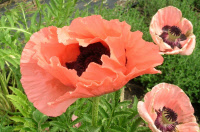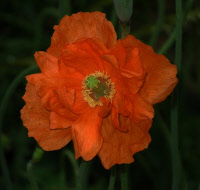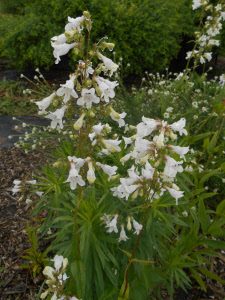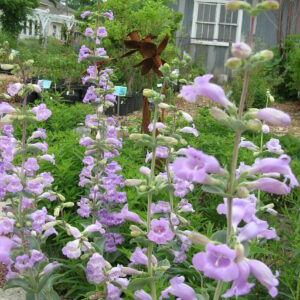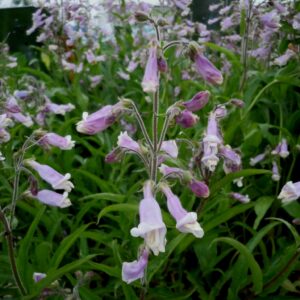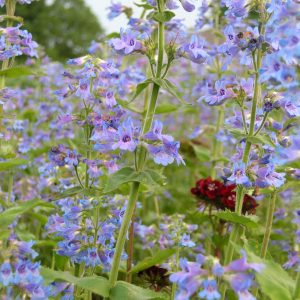Perennials & Biennials
Showing 337–344 of 511 results
-
Papaver orientale ‘Princess Victoria Louise’ Poppy Z 3-7
crinkled, crepe-paper like apricot-pink petals
ARCHIVED
Note: This is a plant not currently for sale. This is an archive page preserved for informational use.
Dramatic, crinkled, crepe-paper like apricot-pink petals with black blotch in center – June. It is an ephemeral, like a tulip; it all disappears in summer and then the leaves reappear in late fall, so don’t be surprised.
Size: 24-30” x 18”
Care: sun in well-drained soilPoppies have been grown since at least the time when Homer wrote the Illiad, in which he used the poppy’s hanging bud as a metaphor for a dying soldier. French botanist Tournefort discovered the classic orange poppy, P. orientale in Armenia in 1714 and sent it to the King of France. This cultivar of the Oriental poppy in gardens since 1908. Princess Victoria Louise (1892-1980) was the only daughter of William II, German Emperor and Empress Augusta Victoria of Prussia and the maternal grandmother of Queen Sophie of Spain and former King Constantine II of the Hellenes. By marriage she was the Duchess of Brunswick. She was a beauty and the flower is aptly named.
-
Papaver orientale Poppy Z 2-7
The classic poppy - papery tabasco petals with black blotch center in June. D.M. Ferry Catalog, 1876:"great beauty and magnificent.” It dies back in summer then the leaves reappear in fall.
OUT OF STOCK
Available for purchase in Spring only
The classic poppy – papery tabasco petals with black blotch center in June. D.M. Ferry Catalog, 1876: ”great beauty and magnificent.” It dies back in summer then the leaves reappear in fall.
Size: 2-3’ x 2’
Care: Full sun in well-drained soil. Drought tolerant
Native: Caucasus
Wildlife Value: Deer resistant.Poppies have been grown since at least the time when Homer wrote the Illiad, in which he used the poppy’s hanging bud as a metaphor for a dying soldier. During World War I, Canadian soldier John McCrae again united the poppy with dying soldiers. He wrote “In Flanders’ Field.” French botanist Joseph Pitton Tournefort (1656-1708) discovered this in Armenia in 1714 and sent it to the Jardin du Roi. Tournefort wrote “the Turks eat the green heads of this Poppy, although they are very bitter and acrid.” In 1741 Englishman Peter Collinson sent seeds to John Bartram (1699-1777) who cultivated the plant in his Philadelphia nursery. Jefferson grew the oriental poppy at Monticello and Washington grew it at Mount Vernon.
-
Papaver rupifragum Spanish poppy Z 5-9
Crinkled, crepe-paper like apricot petals all summer & fall except for a recess in the heat of mid-summer.
Crinkled, crepe-paper like apricot petals all summer & fall except for a recess in the heat of mid-summer
Size: 12-18" x 8"
Care: sun in well-drained to moist well-drained soil. Deer resistant, drought tolerant
Native: Spain, Asia Minor & CaucasusFirst described in Journal of Botany in 1873. Louise Beebe Wilder considered this among her favorite perennials. (1918). One of our favorites too! Gertrude Jekyll, mother of the mixed perennial border planted this for its “rich apricot color.” (1908).
-
Parthenium integrifolium Wild Quinine Z 3-8
Frosty white blooms from July to September
Frosty white blooms from July to October, not especially showy but so reliable and sturdy, excellent. It’s a work horse.
Size: 2-4' x 18"
Care: Full sun in moist well-drained to well-drained soil. Drought tolerant.
Native: Mass. to Georgia, west Minnesota to Arkansas, Wisconsin nativeSeeds fragrant when crushed. Named Quinine because it was used to treat fevers similar to malaria. Catawabe Indians used leaves to treat burns and flowers to treat fever.
-
Penstemon digitalis Foxglove beardtongue Z 2-8
Palest of pink tubular bells
OUT OF STOCK
Palest of pink tubular bells in June – deadhead for rebloom. More vigorous and longer blooming than its well-known cultivar ‘Husker Red.’
Size: 24-48” x 18”
Care: sun or part shade in moist to moist, well-drained soil
Native: Maine to So. Dakota, south to Virginia and Texas and all in between, Wisconsin
Wildlife Value: host for caterpillar of Baltimore Checkerspot butterfly. Feeds several bees and hummingbirds pollen and nectar.Penstemon is named for its five stamens, penta meaning “five” in Greek. Used medicinally by the Dakota and Pawnee – to remedy chest pains, chills and fevers. P. digitalis first transported to Europe when the son of the royal Spanish gardener sent it to Kew in England, 1793.
-
Penstemon grandiflorus Large beard tongue Z 3-9 short-lived perennial that reseeds
Large pink to lavender trumpets along the 3’ stem in early summer
OUT OF STOCK
Large pink to lavender trumpets along the 3’ stem in early summer
Size: 3’ x 10”
Care: full sun in well-drained soil
Native: IL to N. Dakota, south to TX, Wisconsin
Wildlife Value: attracts Baltimore butterflyDiscovered by Thomas Nuttall, (1786-1859) who searched entire No. American continent, describing this Penstemon as “splendid and beautiful,” on his trip up the Missouri River in 1811. Cured chest pains and stomach aches for the Dakota and chills and fever for the Pawnee. Sioux made decoctions of this to remedy chills and fever and chest pain.
-
Penstemon hirsutus Downy penstemon Z. 3-9
Lavender-Pink outside and white inside funnels in June
OUT OF STOCK
Lavender-Pink outside and white inside funnels in June
Size: 20” x 12-24”
Care: sun in well-drained soil
Native: northeast North America
Wildlife Value: feeds native bees, Baltimore butterfly and endangered Rusty patched Bumble BeePenstemon is named for its five stamens, penta meaning “five” and stemon meaning “stamen” in Greek. Penstemons are “handsome and deserving,” Bailey. P. hirsutus sent from America to England in 1758.
-
Penstemon ovatus Beardtongue Z 4-9
Cornflower blue trumpets encircle spike in June, one of our favorites.
OUT OF STOCK
Cornflower blue trumpets encircle spike in June, one of our favorites.
Size: 2’ x 8”
Care: Full sun in well-drained soil
Native: Pacific Northwest
Wildlife Value: attracts Baltimore butterfly, bees, bumblebees, flies, wasps and hummingbirds.Penstemon is named for its five stamens, penta meaning five in Greek. Penstemons. Ovatus means oval, shaped like an egg, with the narrower end up, referring to the foliage. This species first collected by Scottish plant hunter David Douglas (1799-1834) and introduced in 1826.

